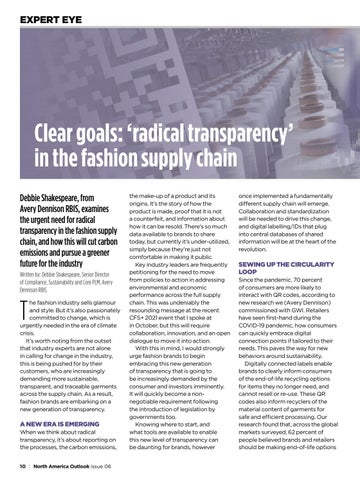EXPERT EYE
Clear goals: ‘radical transparency’ in the fashion supply chain Debbie Shakespeare, from Avery Dennison RBIS, examines the urgent need for radical transparency in the fashion supply chain, and how this will cut carbon emissions and pursue a greener future for the industry Written by: Debbie Shakespeare, Senior Director of Compliance, Sustainability and Core PLM, Avery Dennison RBIS
T
he fashion industry sells glamour and style. But it’s also passionately committed to change, which is urgently needed in the era of climate crisis. It’s worth noting from the outset that industry experts are not alone in calling for change in the industry, this is being pushed for by their customers, who are increasingly demanding more sustainable, transparent, and traceable garments across the supply chain. As a result, fashion brands are embarking on a new generation of transparency.
A NEW ERA IS EMERGING When we think about radical transparency, it’s about reporting on the processes, the carbon emissions, 10 | North America Outlook issue 06
the make-up of a product and its origins. It’s the story of how the product is made, proof that it is not a counterfeit, and information about how it can be resold. There’s so much data available to brands to share today, but currently it’s under-utilized, simply because they’re just not comfortable in making it public. Key industry leaders are frequently petitioning for the need to move from policies to action in addressing environmental and economic performance across the full supply chain. This was undeniably the resounding message at the recent CFS+ 2021 event that I spoke at in October, but this will require collaboration, innovation, and an open dialogue to move it into action. With this in mind, I would strongly urge fashion brands to begin embracing this new generation of transparency that is going to be increasingly demanded by the consumer and investors imminently. It will quickly become a nonnegotiable requirement following the introduction of legislation by governments too. Knowing where to start, and what tools are available to enable this new level of transparency can be daunting for brands, however
once implemented a fundamentally different supply chain will emerge. Collaboration and standardization will be needed to drive this change, and digital labelling/IDs that plug into central databases of shared information will be at the heart of the revolution.
SEWING UP THE CIRCULARITY LOOP Since the pandemic, 70 percent of consumers are more likely to interact with QR codes, according to new research we (Avery Dennison) commissioned with GWI. Retailers have seen first-hand during the COVID-19 pandemic, how consumers can quickly embrace digital connection points if tailored to their needs. This paves the way for new behaviors around sustainability. Digitally connected labels enable brands to clearly inform consumers of the end-of-life recycling options for items they no longer need, and cannot resell or re-use. These QR codes also inform recyclers of the material content of garments for safe and efficient processing. Our research found that, across the global markets surveyed, 62 percent of people believed brands and retailers should be making end-of-life options









